These posts are not for foraging. They are intended for entertainment and intellectual satisfaction only. These posts are not a field guide nor comprehensive in any way - their accuracy is not assured in any way. Do not eat wild mushrooms unless you are a professional, have substantial professional assistance or have a wealth of personal experience with a specific species. Do not make any foraging decisions based on these posts. To do so could be dangerous or life threatening.
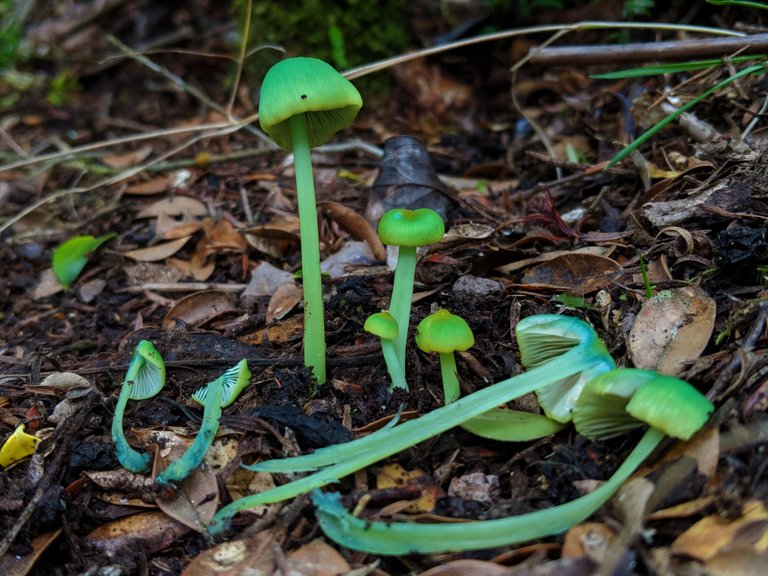
Deep inside of Parque Oncol, we found these very special mushrooms - Entoloma necopinatum.
Or, possibly, Entoloma neonecopinatum. The distinction between the two is presently lost on me, but one of my compatriots who, again, has a great deal more knowledge about these things than I do, labeled the Entoloma's we found in Parque Oncol as "neo" whereas she labeled another sample found further north in Chile without the "neo" addition.
Whether these mushrooms require the addendum "neo" or not is getting pretty deep into the weeds and likely a question to be resolved by DNA testing.
What's more important for the average reader is how mind blowingly beautiful and intensely, fantastically colorful they are. I mean look at that overwhelming, bright green coloration.
Plus, as if that wasn't enough, take a closer look at the areas where the mushrooms have been damaged.
Enhance!

Blue! They stain bright blue.
Yep, these are bright green mushrooms, that stain bright blue when damaged and, as you'll see later, exude pink spores. Does it get more colorful than that? Let's dive in.
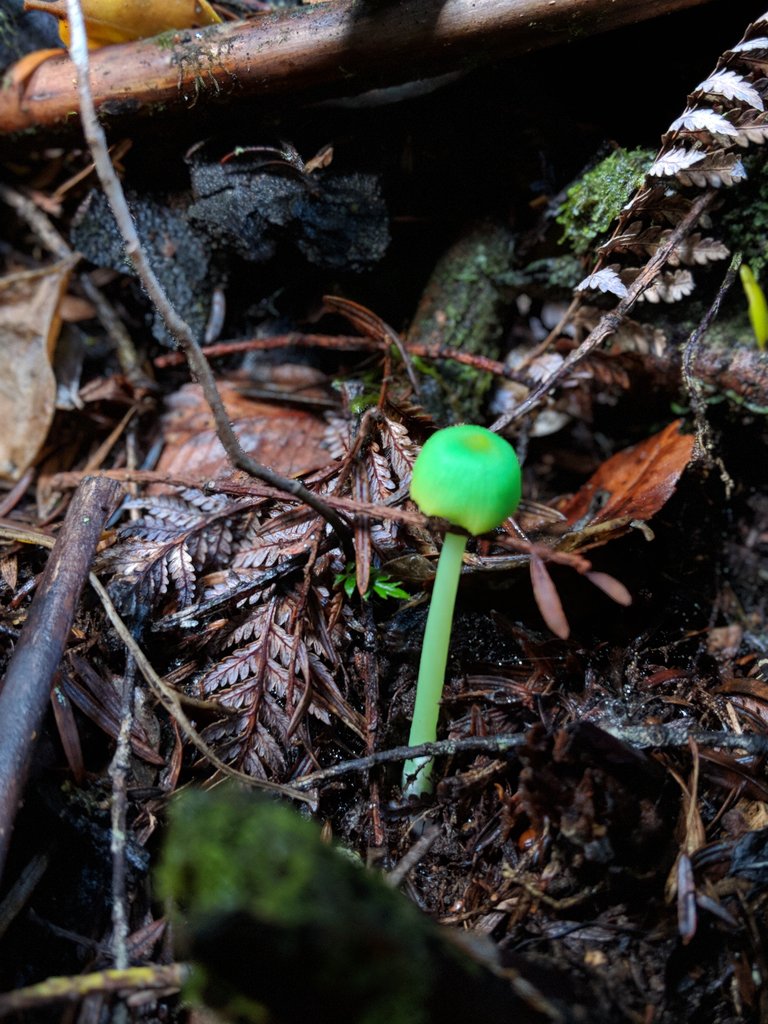
In general Entoloma's can be a difficult genus to parse.
Many of the species are fairly cryptic and often grow alone or in very small groups. They can be confusing to navigate, especially if you're trying to get down to species.
However, these astounding green Entoloma have basically no lookalike in their ecosystem in Chile. In fact, as of 2015, there were only five recorded collections of E.necopinatum in history. The first was in 1977, by Dr. Egon Horak, whose name is now assigned to the E.necopinatum species. Our guide during this trip, Guiliana Furci, collected a sample in 2007 and the Fundación Fungi led a course which resulted in a sample being taken in 2015.
Although I can't be 100% sure, it is safe to say that our group was the 6th or 7th recorded collection of E.necopinatum ever. (Or, an even more exciting possibility, the first collection of a genetically unique species, perhaps E.neonecopinatum).
The long and short of it is that these mushrooms are extraordinarily rare, much more so than last week's beautiful Mycena cyanocephala.
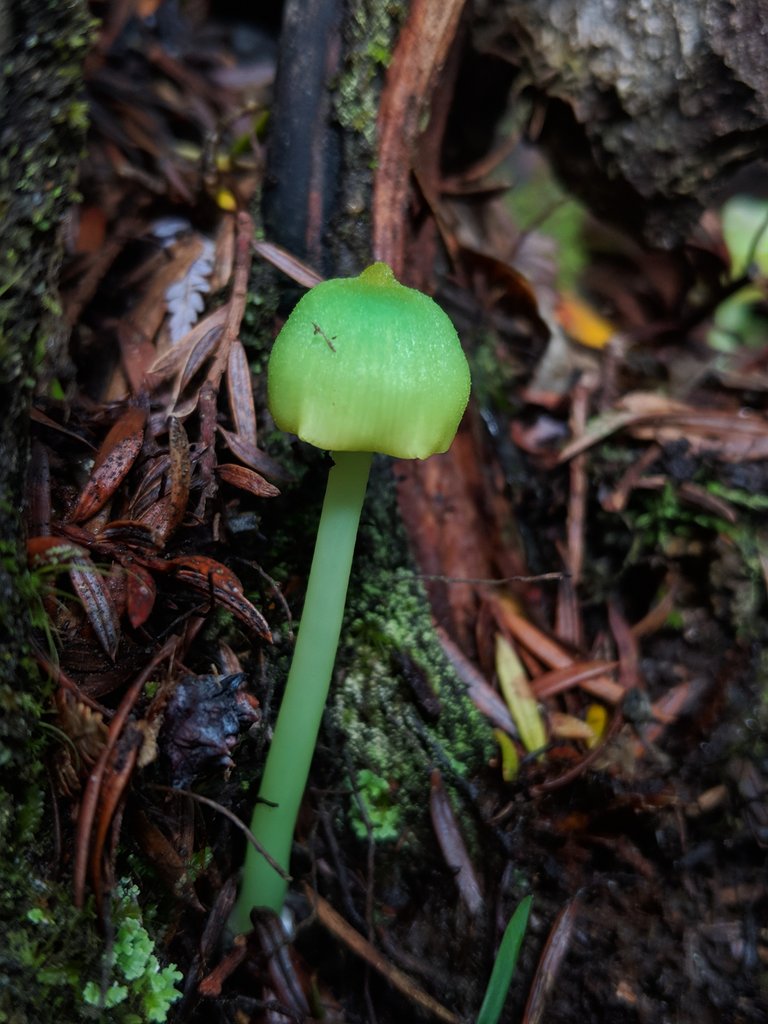
Here's a fruiting body about half way through its development.
If you look at the last photo you can see the bright green color of the very young mushroom, its cap convex, almost a rounded conical shape. The stem is a paler green than the cap, and even that young cap has begun to yellow around the edges and in the very center.
The photo directly above reveals the presence of a defined, fairly sharp umbo - the little pointed yellow bit on the very top of the cap, as well as a the hint of striations or lines coming down vertically along the cap. There also seem to be very fine material on the cap, almost like effervescent sparkles - just the slightest touch of texture.
Let's zoom in a bit on another cap.
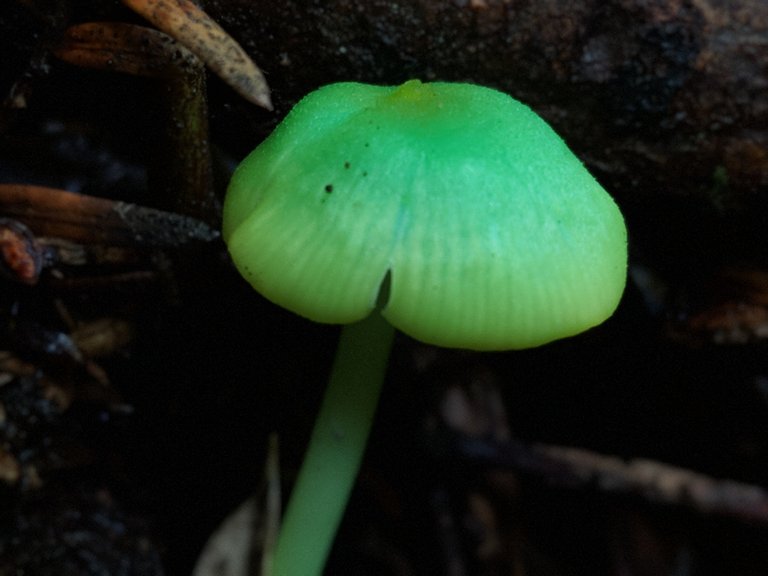
Here you begin to see the cap widening, becoming more broadly convex as the mushroom matures, the striation more apparent.
"Necopinatum", as with most species names, is Latin - but in this case, it has a direct translation - it means "Unexpected."
It's hard to overstate the degree to which that name suits these mushrooms. They appear popping out of the dark, fertile humus of the forest floor of a sudden, strange to the eye even when you've been told by others that they will be there and where to look for them.
The color, like all things, does not last.
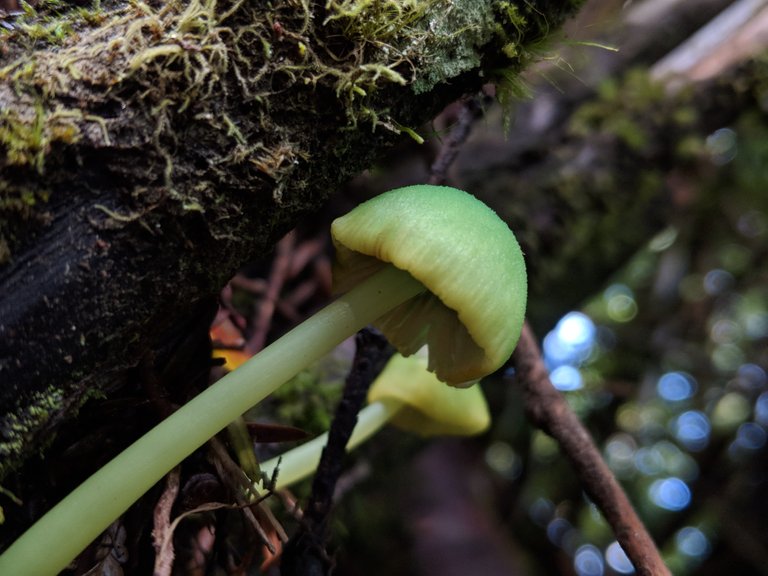
As the mushroom ages it dulls, first around the edges as you see here.
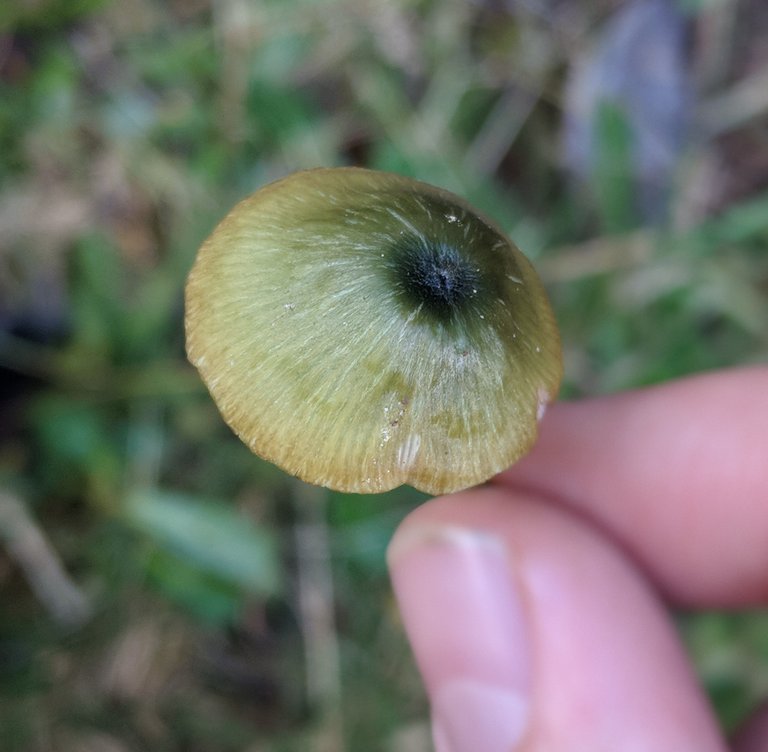
Then all over the eventually definitively convex cap.
You can see here that the bright green fades first to yellow, then to a brown at the edges and darkening shades of dull green, eventually with a darker green spot in the center. The striations along the cap are very prominent by the time the mushroom is fully mature and there even appears to be thin gashes in the cap material from expansion.
Take a look at the gills under this mature cap.
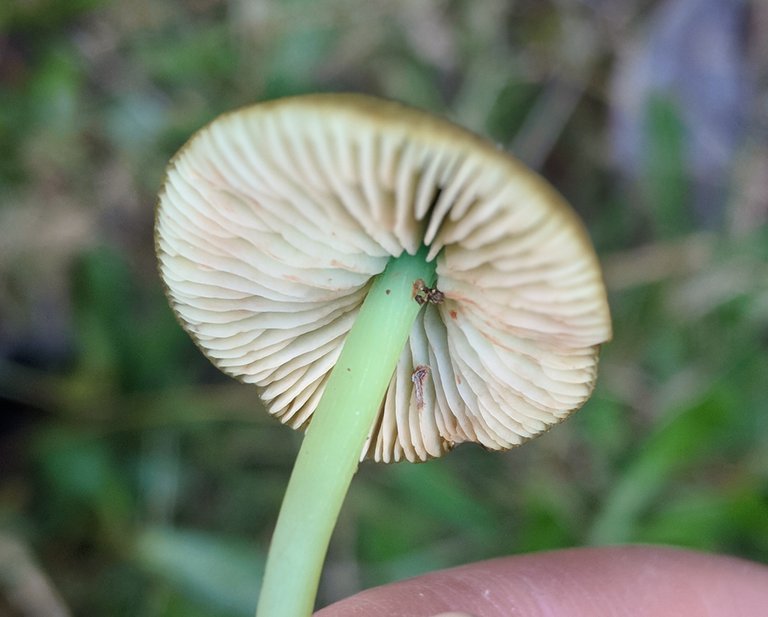
The gills might begin with a hint of green, but do not retain it.
The stem's green color holds up fairly well as the species matures. But, more importantly, if you look closely at the gill edges you can see one of the hallmarks of an Entoloma species, the pink spores, amassing in large numbers in splotches on the gills themselves, once they are mature.
Enhance!

There's a better look of what I'm talking about.
E.necopinatum is such a rare species that it may actually be endangered. There are not a great many resources being put to the task of assessing the health of specific fungal species but, of course, Guiliana is furthering that goal as well. She is working with other international mycologists on The Global Fungal Red List Initiative, an effort to objectively and methodically document the health of specific fungal species and categorize them in much the same way animal species are labeled endangered or threatened.
E.necopinatum is currently only proposed as a possible candidate for the red list, but given the specificity of its habitat and how rarely it is encountered - The Red List Entry for the species estimates it may only exist in ten locations on the planet, all in Chile, with possibly as few as 200 mature fruiting bodies total - it is quite possible it will officially be listed as endangered or threatened in the near future.
Of course, just because E.necopinatum is a green Entoloma limited to Chile, doesn't mean nature doesn't have other aces up her sleeve.
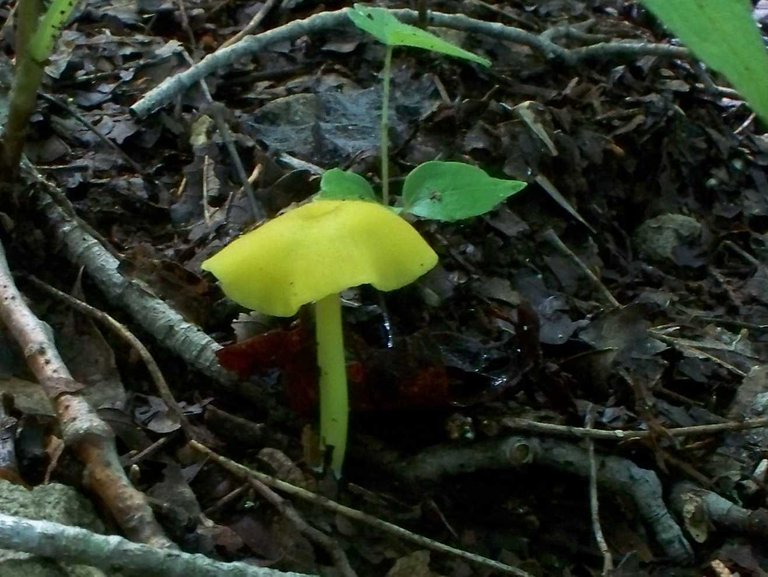
This is Entomloma incanum, and unlike E. necopinatum, it is in North America, east of the Great Plains.
Just in case you thought Chile had the world's only green Entoloma, you should know that there is a chance you will encounter a green Entoloma all your own, without even needing to go all the way to Chile. E.incanum, from the pictures I've seen, is not quite as spectacularly green as E.necopinatum, but it would still make quite the find, and quite the addition to a collection, if I were to ever stumble upon it.
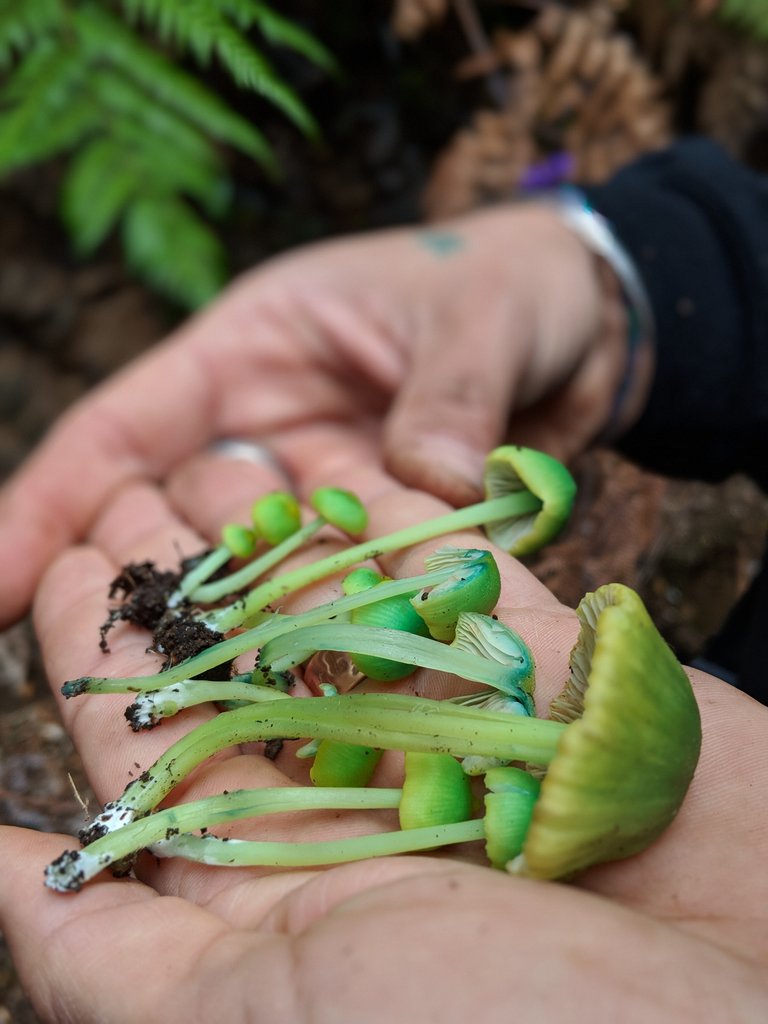
Whether these were E.necopinatum, or, dream of dreams, neonecopinatum, I may never know. But they were among the most incredible of the fungal finds we came across in Chile, and, given their extreme rarity, they might be the rarest living thing I've ever encountered in real life.
As an addendum, here are two other very handsome fungi I photographed while in Parque Oncol. Although they were far less interesting overall, under normal foray conditions, where you're not finding elusive, unicorn-esque fungi, they would have been stand out finds themselves.
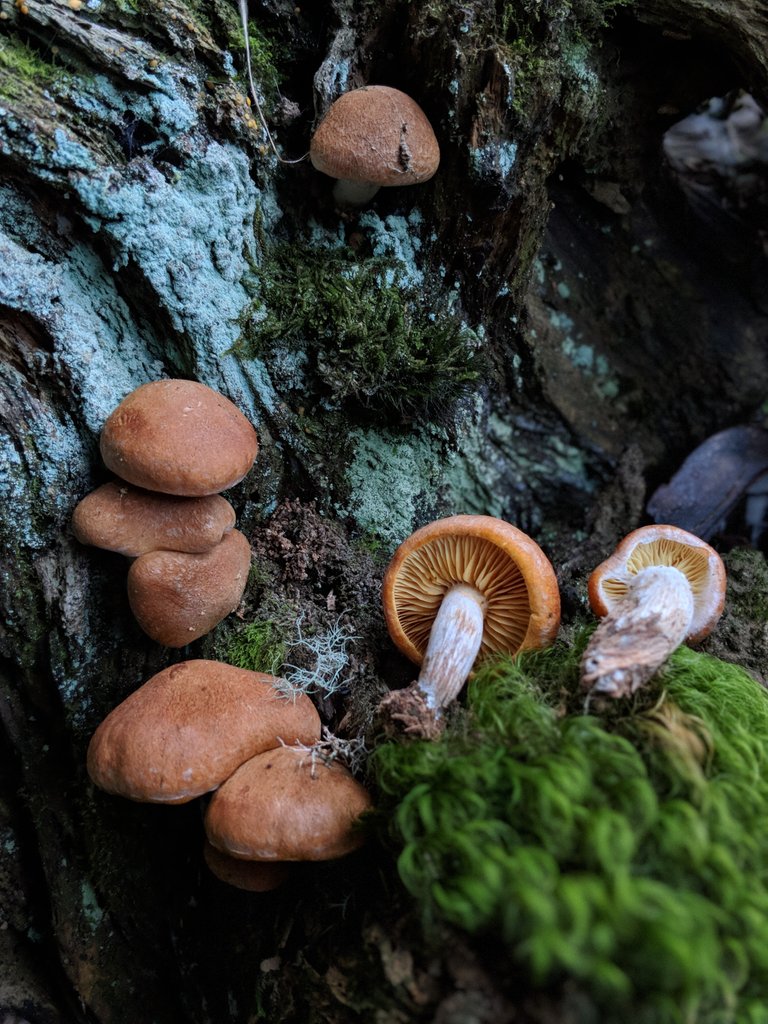
Some kind of Cortinarius. Hard to see here but I think the gills had a greenish tint IRL.
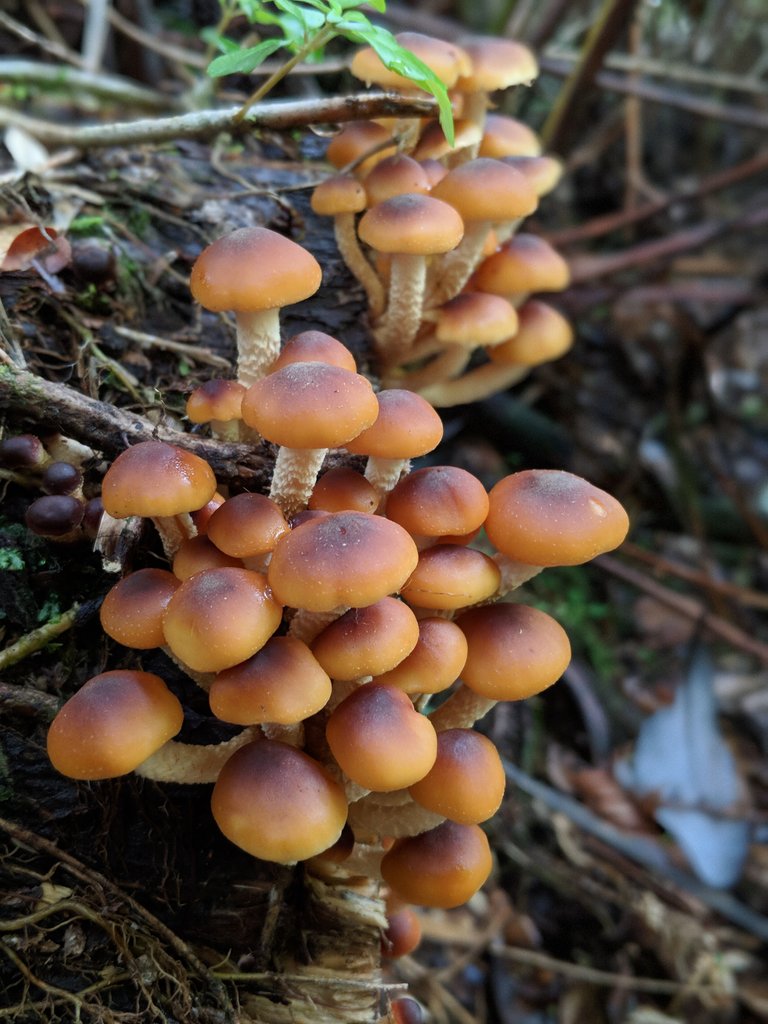
And maybe some kind of Hypholoma species. Who knows?
Next time, we continue our journey through Chile, and go AMANITA CRAZY!
All Photos Are My Own Except:
Information Sources:
- Primary sources were several of the mycologists I went on the trip with in this case, whose photos and identifications I had access to in preparing this post.
- Mycobank.org Entry on E.necopinatum
- The Global Fungal Red List entry on E.necopinatum
- Mushroom Observer on E.necopinatum
- Park Katalapi article on the endangered status of E.necopinatum
- Kuo, M. (2013, January). Entoloma incanum. Retrieved from the MushroomExpert.Com Web site:
- Kuo, M. (2013, January). Entolomatoid mushrooms. Retrieved from the MushroomExpert.Com Web site:
- Wikipedia on Mycologist Dr. Egon Horak
Please support @Steemstem and the #Steemstem community, dedicated to bringing and supporting high quality STEM related content on Steemit.
Let me clarify what I mean by "support." There are a number of good options.
Head over to the steemstem discord channel and the #steemstem tag and start talking with the other users involved in the community, commenting and upvoting on their submissions.
If, like me, you can hardly find time to post your own material once a week, then consider joining the steemstem autovote trail, which you can inquire about on said discord channel.
Or, if, like me, time is very difficult to give to the community, then consider making a delegation. Presently, and for the last half year, I have delegated a third of my SP to the @steemstem account.
It seems we share the same passion: wild flora and fungi.
The beginning of the article is especially useful. The recommendation should be followed by everyone.
It's simpler for me: a plant or a mushroom you're not absolutely sure about, it's poisonous.
The approach seems amazing and I want to be able to write articles that are so complete and documented.
The photos are so vivid that I smell the mushrooms and the soil.
The purpose is to bring attention to the wild resources.
I feel we should use the mother nature's gifts instead of chemicals.
If everybody will turn their attention toward nature preservation, the humanity's future would look different.
Thank you for your great article, this is truly an inspiration! My passion for wild plants inspired me to host a contest on @worldwildflora.
Hey @rbm Here's a tip for your valuable feedback! @Utopian-io loves and incentivises informative comments.
Contributing on Utopian
Learn how to contribute on our website.
Want to chat? Join us on Discord https://discord.gg/h52nFrV.
Vote for Utopian Witness!
I appreciate your reading and your thorough reply. I definitely ascribe to the same mentality when it comes to mycophagy (mushroom eating)!
This is a fascinating find! I never thought that such a green (and blue!) exists on earth (besides on some dragonflies or frogs). Thank you for sharing these experiences and for broadening my horizon. Great!
I'm glad you've enjoyed them - they are certainly among the most colorful fungi I've yet seen in person!
@dber Great post, love the colour of the Mycena cyanocephala, also the @sandlover post is a phishing scam don't login if you click the link. It's not Steemit.
Thanks @digitaldan - and thanks for the heads up. Seemed like a pretty scammy comment and account from the looks of it.
oh the green mushrooms look so cool :DD especially the bright colour, waaw! great informative post about nature and cool to learn on here 😊😊 have a wonderful day!
I'm glad you enjoyed it!
This is so facinating!
Amazing green/blue colors that I only saw on mushrooms that grow on trees before now. Good job and awesome pictures.
I just made a post with pictures of unique fungi I found in the Norwegian forest, maybe you can help me identify any of them?
This was very inspiring to me, thanks for sharing!
🍄
I loved your post - I resteemed it and left a comment with my thoughts for some of the finds. I'd love to see more!
Really enjoyed reading this, your guide sounds like an incredible mind, a truly fun guy!
A truly fun gal :)
But really she is an incredible person with an awesome heart and mind. She made the trip very special.
I love mushrooms but never seen such variety. you gathered such an interesting piece of information. keep up with good work.
This post has been voted on by the steemstem curation team and voting trail.
There is more to SteemSTEM than just writing posts, check here for some more tips on being a community member. You can also join our discord here to get to know the rest of the community!
Thank you guys for your continued support.
There's a few more of these amazing finds from Chile to parse through - and then we'll be back to our normal programming - but with a twist. I've started my own fungi collection, drying and preserving samples. I also bought a nice new microscope, and had to return it to amscope because it was horrirbly infiltrated by dust somehow. But eventually we should be looking at a whole new level of post detail, with tons of awesome reagent reactions and photos of hyphae, cystidia, basidia, and even spore ornamentation and amyloid reactions.
As always, as ever, @steemstem is pushing me towards greater degrees of objective credibility and careful methodology - an impetus I continue to appreciate immensely.
Great post!
Beautiful organisms with which I had the good fortune to work for 4 years and they are really interesting.
So many varied species of mushrooms they all look so crystal clear and bright.
All the photos are looking great.
Looking forward to journey further in Chile.
Thanks for taking a look!
Those green mushrooms are really beautiful. <3
Mushrooms are one of my favorites, although I lack scientific knowledge about them.
My mom used to cook mushrooms when I was a kid. She knows to select edible ones. It was so tasty. I remember one day we got a sack of mushrooms after one thunderstorm day.
Best wishes and looking for more articles from you. :)
That must be a nice memory - and perhaps it means you know a thing or two about foraging?
Not really. But my mom knows to identify edible mushrooms. I am from Kerala, South of India btw :) .
@dber man tell me where and WHEN to look for funny mushrooms in Iceland :D
What are you doing in Iceland @saunter? (Aside from having a great time being in an awesome country... nvm).
Anyways, I'm quite certain, with its generally resplendent natural beauty, that their are a host of amazing fungi in Iceland almost year round. You probably won't find much in the dead of winter, but wait a couple of days after a big rain and head out to any wild green space and look around and I would bet you'll find a lot of stuff.
I'd also think their geographic isolation might result in a few unique local species, but then again fungi have a way of getting around...
I am working here man! It's plenty of rain all the time, the weather's shit :P
That's one way of looking at it - the other is that it's the perfect opportunity to start a fungi hobby! Come to the dark side @saunter!
I am a fungi fan, but I prefer the funny ones ;)
Beautiful photos and wonderful post! I've never seen that before, or read of it. Do you know if it displays fluorescence or bioluminescence?
I don't know actually - it wasn't mentioned as a trait when we saw it.
To an observer like me, That greenish color is just asking for analysis of its chemical structure and fluorescence/emission spectrum. Such a genetic end product and its transcription and translation could be of valuable utility similar to GFP from jellyfish.
What amazing photographs
Thanks!
Incredible!
Thank you for sharing
That's pretty insane dude, nice pics.
You Have Been Up-voted By The Curation A1-Shroom-Spores. For Excellence In The Field Of Mycology! Join The Mushroom Conversation! - https://discord.gg/rXGEqvW.
Who does not like to see the natural scene. Everyone wants to visit the beautiful places of the world. We have become mechanical to see ourselves the buildings of the brick-cement-stone buildings around us. Difficulty in nesting the house. So maybe our mechanical city, where there is a lot of opportunities, as well as our sightseeing. Because we are naturally comfortable. Now we do not go to enjoy the wonderful landscapes at any place of trouble, where we have to face many problems. And that is why we go beyond our sights, some of the wonderful places in the world.
https://steemit.com/photography/@bellmusic/a-journey-through-venezuela-one-photo-every-day-87 I invited you to see mi post
Awesome and professional post! :) Thoroughly enjoyed.
However; I would leave all that mycelium next time.
People will say that it doesn't matter for certain species.
That is bullshiz. Always cut: Never pluck. Especially rare ones.
Thanks!
Regarding harvesting methodologies, I didn't do any of the physically collecting for this species - and I definitely trust the people who did - Guliana in this case. I think in order to have fairly complete samples to dry and observe later she took some of the mycelium along with them.
I imagine it is a constant dilemma for conservationists in general - you want to understand a thing more fully, and so you need to take some back to examine and save of posterity - but you also want them not to be wiped out, and so they have to be preserved in the wild.
I can only assume that if Giuliana was picking them in this way, given that she made the application to have them added to the red list, then the calculus militated in favor of doing so.
But it wasn't something we discussed at the time, so I can't say for certain.
Congratulations @dber! You have completed the following achievement on Steemit and have been rewarded with new badge(s) :
Click on the badge to view your Board of Honor.
If you no longer want to receive notifications, reply to this comment with the word
STOPDo not miss the last post from @steemitboard:
SteemitBoard World Cup Contest - Play-off for third result
Participate in the SteemitBoard World Cup Contest!
Collect World Cup badges and win free SBD
Support the Gold Sponsors of the contest: @good-karma and @lukestokes